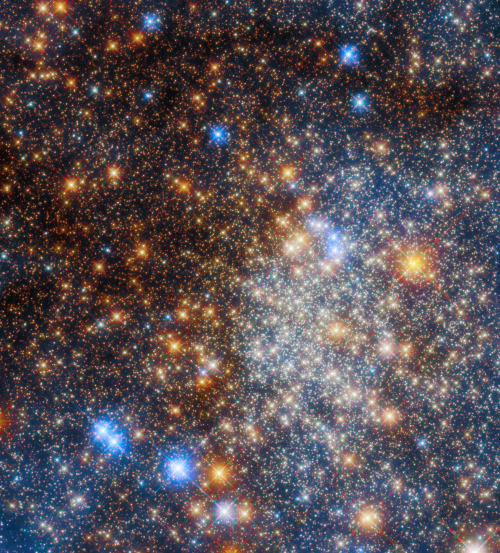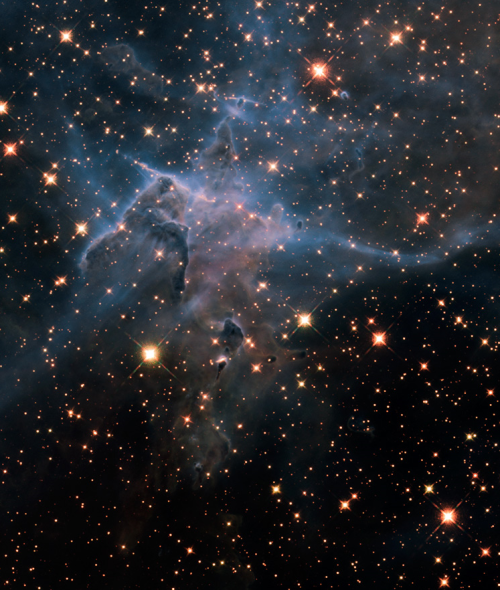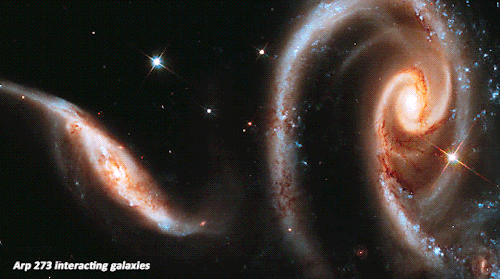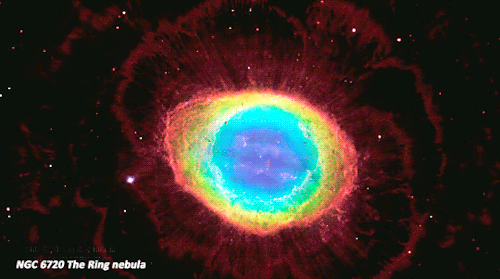Curate, connect, and discover
Hubble - Blog Posts



hubbge .hubble . hubbl e.hubble . i wake up and post hubble
Many things in space stay the same for a human lifetime, but not the Bat Shadow. Hubble pictures taken 404 days apart show it “flapping” as the shadow changes position. It’s the result of a saddle-shaped disk: https://bit.ly/3Y5qu7W
Every February 2, we wonder if Punxsutawney Phil will see his shadow.
In Saturn’s case, astronomers know some of Saturn’s moons will cast shadows across the planet’s iconic rings every 15 years. This effect only occurs when the planet’s rings are perpendicular to the Sun. The next time this will happen is in May 2025.
Watch as four of Saturn’s moons orbit the planet, based on images taken by the Hubble Space Telescope over a 9.5-hour span in 1995. Enceladus is first and Mimas is close behind. Both of these moons cast small shadows on Saturn, but among the two, only Enceladus’ shadow cuts across the rings. Dione follows next and casts a long shadow across the planet’s rings. About 12 seconds in, the moon Tethys moves swiftly behind the planet toward the right.
Credit: NASA/ESA/STScI.

2024 February 4
The Cone Nebula from Hubble Image Credit: Hubble Legacy Archive, NASA, ESA - Processing & Licence: Judy Schmidt
Explanation: Stars are forming in the gigantic dust pillar called the Cone Nebula. Cones, pillars, and majestic flowing shapes abound in stellar nurseries where natal clouds of gas and dust are buffeted by energetic winds from newborn stars. The Cone Nebula, a well-known example, lies within the bright galactic star-forming region NGC 2264. The Cone was captured in unprecedented detail in this close-up composite of several observations from the Earth-orbiting Hubble Space Telescope. While the Cone Nebula, about 2,500 light-years away in Monoceros, is around 7 light-years long, the region pictured here surrounding the cone’s blunted head is a mere 2.5 light-years across. In our neck of the galaxy that distance is just over half way from our Sun to its nearest stellar neighbors in the Alpha Centauri star system. The massive star NGC 2264 IRS, seen by Hubble’s infrared camera in 1997, is the likely source of the wind sculpting the Cone Nebula and lies off the top of the image. The Cone Nebula’s reddish veil is produced by dust and glowing hydrogen gas.
∞ Source: apod.nasa.gov/apod/ap240204.html

Wonderous strange! This unusual arrangement in the sky was one of only 100 known polar-ring galaxies when it was captured by the Hubble Space Telescope in 1999. Officially known to astronomers as NGC 4650A, the polar-rings may be the result of two galaxies colliding. Gas from the smaller galaxy would have been stripped off and captured by the larger galaxy, forming a new ring of dust, gas, and stars, which orbit the inner galaxy almost at right angles to the old disk. In addition to learning about galaxy interaction, astronomers use polar-ring galaxies like this to study dark matter, which does not emit light or interact with normal matter (except through gravity), making it difficult to understand. Both the old, rotating disk and the dark matter surrounding this galaxy pull on its polar ring. The alignment of the ring along the pole of the inner disk's rotation allows scientists to probe this combination of tugs and thus the distribution of dark matter. Credit: NASA, ESA, STScI. ALT TEXT: Two galaxies appear to intersect at right angles. Vertically there is a bright column of dust and stars, and horizontally there is a smaller hazy yellow band, brighter at its center, with no discernable stars. In the space around and behind the intersecting forms are smaller stars and distant galaxies colored yellow and red.

Webb + Hubble > peanut butter + chocolate? We think so!
In this image of galaxy cluster MACS0416, the Hubble and James Webb space telescopes have united to create one of the most colorful views of the universe ever taken. Their combination of visible and infrared light yields vivid colors that give clues to the distances of galaxies (blue = close, red = far).
Looking at the combined data, scientists have spotted a sprinkling of sources that vary over time, including highly magnified supernovas and even individual stars billions of light-years away.
Credit: NASA, ESA, CSA, STScI, J. Diego (Instituto de Fisica de Cantabria, Spain), J. D’Silva (U. Western Australia), A. Koekemoer (STScI), J. Summers & R. Windhorst (ASU), and H. Yan (U. Missouri).
ALT TEXT: A field of galaxies on the black background of space. In the middle, stretching from left to right, is a collection of dozens of yellowish spiral and elliptical galaxies that form a foreground galaxy cluster. They form a rough, flat line along the center. Among them are distorted linear features, which mostly appear to follow invisible concentric circles curving around the center of the image. The linear features are created when the light of a background galaxy is bent and magnified through gravitational lensing. At center left, a particularly prominent example stretches vertically about three times the length of a nearby galaxy. A variety of brightly colored, red and blue galaxies of various shapes are scattered across the image, making it feel densely populated. Near the center are two tiny galaxies compared to the galaxy cluster: a very red edge-on spiral and a very blue face-on spiral, which provide a striking color contrast.

If galaxies could talk, we’d want to ask for this galaxy’s skincare routine!
Meet I Zwicky 18, a galaxy lying 60 million light-years away in the constellation Ursa Major.
The bluish-white knots in the center are regions where stars are forming at a rapid rate. These large hubs of stellar creation and the lack of heavy elements in the surrounding gas caused astronomers to think that this dwarf irregular galaxy was very young, since it resembles galaxies in the early universe.
However, the Hubble Space Telescope revealed that I Zwicky 18 is more mature than it first appears. Hubble found faint, older stars within the galaxy, indicating that I Zwicky 18 has been forming stars for more than a billion years.
Credit: NASA, ESA, A. Aloisi (Space Telescope Science Institute and European Space Agency).
ALT TEXT: A bright white and blue oval-shaped area takes up most of the view and is largely centered. Cloud-like wisps of blue material surround the bright-white center, forming a fluffy wreath-like shape. The fluffy material begins as light blue near the center and gradually darkens moving outward. Stars, seen as many bright white and yellow small points of light, are densely grouped in the white and light blue region, forming two roughly circular clumps, one in the upper left and one in the lower right. The corners of the image are dark and mostly empty, with a few larger, fuzzy yellow points of light scattered infrequently throughout.

What is casting dark shadows across 36,000 light-years of space in this Hubble Space Telescope image?
The mysterious dark rays appearing to emanate from galaxy IC 5063 have intrigued astronomers, and there are a few different ideas about what is causing them. They could be like the shadows of clouds when light from the setting Sun pierces through them.
Astronomers have traced the rays back to the galaxy’s core, the location of an active supermassive black hole. One idea suggests that the shadows are being cast into space by an inner tube-shaped ring, or torus, of dusty material surrounding the black hole.
Credit: NASA, ESA, and W.P. Maksym (CfA).
ALT TEXT: Rust-colored view of space, with a bright, narrow purple region at the center, a galaxy. Background stars and galaxies are scattered sparsely—this is a dusty rather than starry scene. To the upper left of the bright central region are dark dust lanes. Opposite these to the lower right, one dark area extends from the central bright region and splits into two dark rays. Similar dark rays can be seen to the top left, behind the dust lanes. The edges of the entire image are dark, fading from the colored center.

This striking image captures the interacting galaxy pair known as Arp-Madore 2339-661, so named because they belong to the Arp-Madore catalogue of peculiar galaxies. However, this particular peculiarity might be even odder than first meets the eye, as there are in fact three galaxies interacting here, not just two.
The two clearly defined galaxies are NGC 7733 (smaller, lower right) and NGC 7734 (larger, upper left). The third galaxy is currently referred to as NGC 7733N, and can actually be spotted in this picture if you look carefully at the upper arm of NGC 7733, where there is a visually notable knot-like structure, glowing with a different colour to the arm and obscured by dark dust.
Credit: ESA/Hubble & NASA

Pumpkin space latte, anyone? ☕
Hubble captured this festive array of stars, Terzan 12, found in the Milky Way about 15,000 light-years from Earth. The stars in this cluster are bound together by gravity in a sphere-like shape and are shrouded in gas and dust. As the starlight travels through that gas and dust to Earth, blue light scatters, leaving the redder wavelengths to come through.
Download the full-resolution image here.
Make sure to follow us on Tumblr for your regular dose of space!
Horsehead Nebula
Hubble (2013) | Euclid (2023)


O Telescópio Espacial Hubble (TEH, HST na sigla em inglês), nomeado em homenagem ao astrônomo Edwin Powell Hubble, foi lançado pela NASA a bordo do Ônibus Espacial Discovery em 24 de abril de 1990
The Hubble Space Telescope (TEH, HST), named after astronomer Edwin Powell Hubble, was launched by NASA aboard the Space Shuttle Discovery on April 24, 1990


Hubble has discovered a dwarf star that devours its own solar system. It's like a cosmic cannibal

Astronomers used archival data from the Hubble Space Telescope and other observatories to analyze the spectral properties of the white dwarf star G238-44.
Detected elements show that the dead star swallows debris from both the inside and the outside of its system. It's a case of "cosmic cannibalism," say the study's authors, published on the Hubble Telescope website.
G238-44 was a Sun-like star that lost its outer layers and no longer burned fuel through nuclear fusion. The discovery that stellar debris simultaneously captures matter from its asteroid belt and Kuiper belt-like regions at the edge of the solar system, including ice bodies, is significant because it suggests that a "water tank" may be a common feature in outer areas. of planetary systems.
‼️When a star like the Sun expands and becomes a red giant, at the end of its life, it loses mass by releasing its outer layers.
➡️A consequence of this may be the gravitational scattering of small objects, such as asteroids, comets and satellites, to the large planets in the system. Hit in this way, surviving objects can be thrown into very eccentric orbits.‼️
☑️ "After the phase of the red giant, the remaining white dwarf star is compact - no bigger than Earth. The planets get very close to the star and experience strong forces of attraction that break them to pieces, creating a disk of gas and dust that eventually falls on the surface of the white dwarf star, "said Johnson.
The #HubbleTelescope captured these auroras on #jupiter caused by light waves interacting with the planet’s magnetic fields.
The Hubble Space telescope just sent back a new photo of the Twin Jet Nebula. Here’s what it looked like in 1997:

And now …

Whoa. But wait, we also got an updated image of the merging galaxies NGC 6240. What it looked like in 2008:

And today:

Science, you’re the best. Oh, and the explanation behind those merging galaxies and their black holes is wild.

The Mystic Mountain - HH 901
This is a NASA Hubble Space Telescope near-infrared-light image of a three-light-year-tall pillar of gas and dust that is being eaten away by the brilliant light from nearby stars in the tempestuous stellar nursery called the Carina Nebula, located 7,500 light-years away in the southern constellation Carina. The image marks the 20th anniversary of Hubble’s launch and deployment into an orbit around Earth.
The image reveals a plethora of stars behind the gaseous veil of the nebula’s wall of hydrogen, laced with dust. The foreground pillar becomes semi-transparent because infrared light from background stars penetrates through much of the dust. A few stars inside the pillar also become visible. The false colors are assigned to three different infrared wavelength ranges.
Credit: NASA, ESA

Thousands of Stars in the Orion Nebula
Close inspection of the 2006 Hubble Space Telescope color mosaic of the Orion Nebula (M42) reveals numerous treasures that reside within the nearby, intense star- forming region. Southwest of the Trapezium stars located in the center of the nebula, a stunning Hubble Heritage portrait captures a variety of intricate objects. Deeply contrasting areas of light and dark blend with a palette of colors mix to form rich swirls and fluid motions that would make even the best artists stand back and admire their work.
Visible slightly bottom right center is the star LL Orionis (LL Ori), originally release by the Hubble Heritage Project in 2002. The delicate bow shock that surrounds LL Ori points towards the stream of gas flowing slowly away from the center of the Orion Nebula, near the Trapezium stars located off the image to the upper left. Close examination of the ends of the bow shock show secondary shocks that are formed as a two-sided jet of gas flowing away from this forming star at high velocity strikes the stream of low velocity gas from the center. To the right of LL Ori, a ghostly veil of material hangs thick and dark, obscuring portions of the nebula behind it.
Credit: NASA/Hubble

“The shockwave from a 20,000 year-old supernova explosion in the constellation of Cygnus is still expanding into interstellar space. The collision of this fast moving wall of gas with a stationary cloud has heated it causing it to glow in visible as well as high energy radiation, producing the nebula known as the Cygnus Loop (NGC 6960/95). The nebula is located a mere 1,400 light-years away. The colors used here indicate emission from different kinds of atoms excited by the shock: oxygen-blue, sulfur-red, and hydrogen-green. This picture was taken with the Wide Field and Planetary Camera 2 on board the Hubble Space Telescope.”
Photo by J Hester of ASU, description via NASA.

Hubble reveals heart of Lagoon Nebula
#beautiful

Hubble Space Telescope Image of Globular Cluster NGC 6397
Credit: NASA, ESA, and H. Richer (University of British Columbia)
#beautiful

Hubble Space Telescope Image of Globular Cluster NGC 6397
Credit: NASA, ESA, and H. Richer (University of British Columbia)
#beautiful










The Best of Hubble_1
NASA’s Hubble Spots Possible Water Plumes Erupting on Jupiter's Moon Europa

This composite image shows suspected plumes of water vapor erupting at the 7 o’clock position off the limb of Jupiter’s moon Europa. The plumes, photographed by NASA’s Hubble’s Space Telescope Imaging Spectrograph, were seen in silhouette as the moon passed in front of Jupiter. Hubble’s ultraviolet sensitivity allowed for the features -- rising over 100 miles (160 kilometers) above Europa’s icy surface -- to be discerned. The water is believed to come from a subsurface ocean on Europa. The Hubble data were taken on January 26, 2014. The image of Europa, superimposed on the Hubble data, is assembled from data from the Galileo and Voyager missions.Credits: NASA/ESA/W. Sparks (STScI)/USGS Astrogeology Science Center
Astronomers using NASA's Hubble Space Telescope have imaged what may be water vapor plumes erupting off the surface of Jupiter's moon Europa. This finding bolsters other Hubble observations suggesting the icy moon erupts with high altitude water vapor plumes.
The observation increases the possibility that missions to Europa may be able to sample Europa’s ocean without having to drill through miles of ice.
“Europa’s ocean is considered to be one of the most promising places that could potentially harbor life in the solar system,” said Geoff Yoder, acting associate administrator for NASA’s Science Mission Directorate in Washington. “These plumes, if they do indeed exist, may provide another way to sample Europa’s subsurface.”
The plumes are estimated to rise about 125 miles (200 kilometers) before, presumably, raining material back down onto Europa's surface. Europa has a huge global ocean containing twice as much water as Earth’s oceans, but it is protected by a layer of extremely cold and hard ice of unknown thickness. The plumes provide a tantalizing opportunity to gather samples originating from under the surface without having to land or drill through the ice.
The team, led by William Sparks of the Space Telescope Science Institute (STScI) in Baltimore observed these finger-like projections while viewing Europa's limb as the moon passed in front of Jupiter.
The original goal of the team's observing proposal was to determine whether Europa has a thin, extended atmosphere, or exosphere. Using the same observing method that detects atmospheres around planets orbiting other stars, the team realized if there was water vapor venting from Europa’s surface, this observation would be an excellent way to see it.
"The atmosphere of an extrasolar planet blocks some of the starlight that is behind it," Sparks explained. "If there is a thin atmosphere around Europa, it has the potential to block some of the light of Jupiter, and we could see it as a silhouette. And so we were looking for absorption features around the limb of Europa as it transited the smooth face of Jupiter."
In 10 separate occurrences spanning 15 months, the team observed Europa passing in front of Jupiter. They saw what could be plumes erupting on three of these occasions.
This work provides supporting evidence for water plumes on Europa. In 2012, a team led by Lorenz Roth of the Southwest Research Institute in San Antonio, detected evidence of water vapor erupting from the frigid south polar region of Europa and reaching more than 100 miles (160 kilometers) into space. Although both teams used Hubble's Space Telescope Imaging Spectrograph instrument, each used a totally independent method to arrive at the same conclusion.
"When we calculate in a completely different way the amount of material that would be needed to create these absorption features, it's pretty similar to what Roth and his team found," Sparks said. "The estimates for the mass are similar, the estimates for the height of the plumes are similar. The latitude of two of the plume candidates we see corresponds to their earlier work."
But as of yet, the two teams have not simultaneously detected the plumes using their independent techniques. Observations thus far have suggested the plumes could be highly variable, meaning that they may sporadically erupt for some time and then die down. For example, observations by Roth’s team within a week of one of the detections by Sparks’ team failed to detect any plumes.
If confirmed, Europa would be the second moon in the solar system known to have water vapor plumes. In 2005, NASA's Cassini orbiter detected jets of water vapor and dust spewing off the surface of Saturn's moon Enceladus.
Scientists may use the infrared vision of NASA’s James Webb Space Telescope, which is scheduled to launch in 2018, to confirm venting or plume activity on Europa. NASA also is formulating a mission to Europa with a payload that could confirm the presence of plumes and study them from close range during multiple flybys.
“Hubble’s unique capabilities enabled it to capture these plumes, once again demonstrating Hubble’s ability to make observations it was never designed to make,” said Paul Hertz, director of the Astrophysics Division at NASA Headquarters in Washington. “This observation opens up a world of possibilities, and we look forward to future missions -- such as the James Webb Space Telescope -- to follow up on this exciting discovery.”
The work by Sparks and his colleagues will be published in the Sept. 29 issue of the Astrophysical Journal.
The Hubble Space Telescope is a project of international cooperation between NASA and ESA (the European Space Agency.) NASA's Goddard Space Flight Center in Greenbelt, Maryland, manages the telescope. STScI, which is operated for NASA by the Association of Universities for Research in Astronomy in Washington, conducts Hubble science operations.
For images and more information about Europa and Hubble, visit:
http://www.nasa.gov/hubble & http://hubblesite.org/news/2016/33
Sean Potter / Laurie Cantillo Headquarters, Washington 202-358-1536 / 202-358-1077 sean.potter@nasa.gov / laura.l.cantillo@nasa.gov
Ann Jenkins / Ray Villard Space Telescope Science Institute, Baltimore 410-338-4488 / 410-338-4514 jenkins@stsci.edu / villard@stsci.edu
RELEASE 16-096

Hubble Finds a Lenticular Galaxy Standing Out in the Crowd
A lone source shines out brightly from the dark expanse of deep space, glowing softly against a picturesque backdrop of distant stars and colorful galaxies.
Captured by the NASA/ESA Hubble Space Telescope’s Advanced Camera for Surveys (ACS), this scene shows PGC 83677, a lenticular galaxy — a galaxy type that sits between the more familiar elliptical and spiral varieties.
It reveals both the relatively calm outskirts and intriguing core of PGC 83677. Here, studies have uncovered signs of a monstrous black hole that is spewing out high-energy X-rays and ultraviolet light.
Text Credit: ESA (European Space Agency)

Bright Planetary Nebula NGC 7027 from Hubble via NASA http://ift.tt/2El8BGj
La nebulosa NGC 7027 se encuentra en la constelación de Cygnus (el cisne) a unos 3000 años luz de distancia de la Tierra.
Fue descubierta en 1878 por Édouard Stephan
Lo que observamos en la imagen es la descomposición de una gigante roja tras su muerte: nubes concéntricas provenientes de la capa exterior de la estrella (forma esférica), nubes de polvo con forma no-esférica provenientes del resto de capas de la estrella (zona brillante de la imagen) y lo que queda de la estrella es la enana blanca (punto blanco en el centro de la nebulosa).
Comenzó a expandirse hace unos 600 años y tiene una masa 3 veces la del Sol.
NGC 7027 parece ser un lugar prometedor para buscar la existencia de HeH+, molécula que se cree que existe en el espacio interestelar pero que no se ha podido identificar todavía.


